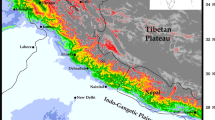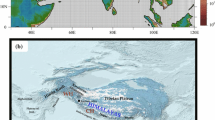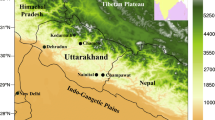Abstract
An intriguing feature associated with ‘breaks’ in the Indian summer monsoon is the occurrence of intense/flood-producing precipitation confined to central-eastern parts of the Himalayan (CEH) foothills and north-eastern parts of India. Past studies have documented various large-scale circulation aspects associated with monsoon-breaks, however the dynamical mechanisms responsible for anomalous precipitation enhancement over CEH foothills remain unclear. This problem is investigated using diagnostic analyses of observed and reanalysis products and high-resolution model simulations. The present findings show that the anomalous precipitation enhancement over the CEH foothills during monsoon-breaks emerges as a consequence of interactions between southward intruding mid-latitude westerly troughs and the South Asian monsoon circulation in its weak phase. These interactions facilitate intensification of mid-tropospheric cyclonic vorticity and strong ascending motion over the CEH foothills, so as to promote deep convection and concentrated rainfall activity over the region during monsoon-breaks. Mesoscale orographic effects additionally tend to amplify the vertical motions and precipitation over the CEH foothills as evidenced from the high-resolution model simulations. It is further noted from the model simulations that the coupling between precipitation and circulation during monsoon-breaks can produce nearly a threefold increase of total precipitation over the CEH foothills and neighborhood as opposed to active-monsoon conditions.

















Similar content being viewed by others
References
Ahrens CD, Samson P (2011) Extreme weather and climate. Brooks/Cole Cengage Learning, 508 pp
Alexander G, Keshavamurty R, De U, Chellapa R, Das S, Pillai P (1978) Fluctuations of monsoon activity. J Meteorol Hydrol Geophys 29:76–87
Anders AG, Roe H, Hallet B, Montgomery DR, Finnegan NJ, Putkonen J (2006) Spatial patterns of precipitation and topography in the Himalaya. GSA Bull Spec Pap 398:39–53
Annamalai H, Slingo JM (2001) Active/break cycles: diagnosis of the intraseasonal variability of the Asian summer monsoon. Clim Dyn 18:85–102
Annamalai H, Sperber KR (2005) Regional heat sources and the active and break phases of boreal summer intraseasonal (30–50 day) variability. J Atmos Sci 62:2726–2748
Asnani GC (1993) Tropical meteorology. Noble Printers, Pune, 1202 pp
Bollasina M, Nigam S (2010) The summertime “heat” low over Pakistan/northwestern India: evolution and origin. Clim Dyn. doi:10.1007/s00382-010-0879-y
Bookhagen B, Burbank DW (2010) Toward a complete Himalayan hydrological budget: spatiotemporal distribution of snowmelt and rainfall and their impact on river discharge. J Geophys Res 115. doi:10.1029/2009F001426
Boos WR, Kuang Z (2010) Dominant control of the South Asian monsoon by orographic insulation versus plateau heating. Nature 463. doi:10.1038/nature08707
Cadet KL, Daniel P (1988) Long-range forecast of the break and active summer monsoon. Tellus 40:133–150
Chen F, Dudhia J (2001) Coupling an advanced land surface–hydrology model with the Penn State–NCAR MM5 modeling system. Part I: model implementation and sensitivity. Mon Weather Rev 129:569–585
Choudhury A, Krishnan R (2011) Dynamical response of the south Asian monsoon trough to latent heating from stratiform and convective precipitation. J Atmos Sci 68:1347–1363
Dairaku K, Emori S (2006) Dynamic and thermodynamic influences on intensified daily rainfall during Asian summer monsoon under doubled atmospheric CO2 conditions. Geophys Res Lett 33:L010704. doi:10.1029/2005GL024754
Dairaku K, Emori S, Nozawa T (2008) Impacts of global warming on hydrological cycles in the Asian monsoon region. Adv Atmos Sci 25:960–973
Das PK (2002) The monsoons. National Book Trust of India, New Delhi, 254 pp
Dash SK, Kulkarni MA, Mohanty UC, Prasad K (2009) Changes in the characteristics of rain events in India. J Geophys Res Atmos 114:D10109
De US, Lele RR, Natu JC (1998) Breaks in southwest monsoon. India Meteorological Department, Report No. 1998/3
Dee DP et al (2011) The ERA–Interim reanalysis: configuration and performance of the data assimilation system. Q J R Meteorol Soc 137:553–597
Dhar ON, Nandargi S (2000) A study of floods in the Brahmaputra Basin in India. Int J Climatol 20:771–781
Dhar ON, Nandargi S (2004) Floods in north Indian River systems. In: Valdiya KS (ed) In coping with natural hazards: Indian context. Orient Longman, Andhra Pradesh, pp 104–123
Dhar ON, Soman MK, Mulye SS (1984) Rainfall over the southern slopes of the Himalayas and the adjoining plains during breaks in the monsoon. J Climatol 4:671–676
Dudhia J (1989) Numerical study of convection observed during the winter monsoon experiment using a mesoscale two-dimensional model. J Atmos Sci 46:3363–3391
Ek MB, Mitchell KE, Lin Y, Rogers E, Grummann P, Koren V, Gayno G, Tarpley JD (2003) Implementation of Noah land surface model advances in the National Centers for Environmental Prediction operational mesoscale Eta model. J Geophys Res 108(D22):8851
Gadgil S, Joseph PV (2003) On breaks of the Indian monsoon. Proc Indian Acad Sci 112:529–558
Goswami BN (2012) South Asian monsoon. In: Lau WKM, Waliser DD (eds) Intraseasonal variability in the atmosphere–ocean climate system. Springer, Berlin, pp 21–64
Goswami BN, Venugopal V, Sengupta D, Madhusoodanan MS, Xavier PK (2006) Increasing trend of extreme rain events over India in a warming environment. Science 1442–1445. doi:10.1126/science.1132027
Goswami BN, Wheeler MC, Gottschalck JC, Waliser DE (2011) Intraseasonal variability and forecasting: a review of recent research. In: Chang CP et al (eds) The global monsoon system: research and forecast. World Scientific, Singapore, pp 389–409
Guhathakurtha P, Sreejith OP, Menon PA (2011) Impact of climate change on extreme rainfall events and flood risk in India. J Earth Syst Sci 120:359–373
Hahn DG, Manabe S (1975) The role of mountains in the south Asian monsoon circulation. J Atmos Sci 32:1515–1541
Hamilton MG (1977) Some aspects of break and active monsoon over southern Asia during summer. Tellus 29:335–344
Hartmann DL, Michelsen ML (1989) Intra-seasonal periodicities in Indian rainfall. J Atmos Sci 46:2838–2862
Jain SK, Agarwal PK, Singh VP (2007) Hydrology and water resources in India. Springer, New York, 1257 pp
Janjić ZI (1996) The surface layer in the NCEP Eta model. In: Preprints, 11th conference on numerical weather prediction, Norfolk, VA, Am Meteorol Soc, pp 354–355
Janjić ZI (2001) Nonsingular implementation of the Mellor–Yamada Level 2.5 scheme in the NCEP meso model, NCEP Office Note, No. 437, 61 pp
Joseph PV, Simon A (2005) Weakening trend of the southwest monsoon current through peninsular India from 1950 to the present. Curr Sci 89:687–694
Kain JS (2004) The Kain–Fritsch convective parameterization: an update. J Appl Meteorol 43:170–181
Kain JS, Fritsch JM (1993) Convective parameterization for mesoscale models: the Kain–Fritsch scheme. The representation of cumulus convection in numerical models. Meteorol Monogr 24, Am Meteorol Soc, pp 165–170
Kalsi SR et al (2004) Various aspects of unusual behaviour of monsoon 2002. Meteorol Monogr, India Meteorological Department, Pune, 105 pp
Koteswaram P (1958) The easterly jet stream in the tropics. Tellus 10:43–57
Krishnamurti TN, Ardanuy P (1980) The 10–20 day westward propagating mode and breaks in monsoon. Tellus 32:15–26
Krishnamurti TN, Low-Nam S, Kumar A, Sheng J, Sugi M (1987) Numerical weather prediction of monsoons. In: Chang C-P, Krishnamurti TN (eds) Monsoon meteorology (Oxford monographs on geology and geophysics). Oxford University Press, Oxford, pp 501–544
Krishnamurti TN, Thomas A, Simon A, Kumar V (2010) Desert air incursions, an overlooked aspect, for the dry spells in the Indian summer monsoon. J Atmos Sci 67:3423–3441
Krishnan R, Zhang C, Sugi M (2000) Dynamics of breaks in the Indian summer monsoon. J Atmos Sci 57:1354–1372
Krishnan R, Kumar V, Sugi M, Yoshimura J (2009) Internal feedbacks from monsoon–mid-latitude interactions during droughts in the Indian summer monsoon. J Atmos Sci 66:553–578
Krishnan R, Ayantika DC, Kumar V, Pokhrel S (2011) The long-lived monsoon depressions of 2006 and their linkage with the Indian Ocean dipole. Int J Climatol 31:1334–1352
Lin YL, Chiao S, Wang TA, Kaplan ML, Weglarz RP (2001) Some common ingredients for heavy orographic rainfall. Weather Forecast 16:633–660
May W (2004) Potential future changes in the Indian summer monsoon due to greenhouse warming: analysis of mechanisms in a global time-slice experiment. Clim Dyn 22:389–414
Mellor GL, Yamada T (1974) A hierarchy of turbulence closure models for planetary boundary layers. J Atmos Sci 31:1791–1806
Mellor GL, Yamada T (1982) Development of a turbulence closure model for geophysical fluid problems. Rev Geophys Space Phys 20:851–875
Mlawer EJ, Taubman SJ, Brown PD, Iacono MJ, Clough SA (1997) Radiative transfer for inhomogeneous atmosphere: RRTM, a validated correlated-k model for the longwave. J Geophys Res 102(D14):16663–16682
Mohapatra M, Mohanty UC (2004) Some characteristics of low pressure systems and summer monsoon rainfall over Orissa. Curr Sci 87:1245–1255
Nandargi S, Dhar ON (2012) Extreme rainstorm events over the Northwest Himalayas during 1875–2010. J. Hydrometeorol 13:1383–1388
Orlanski I (1975) A rational subdivision of scales for atmospheric processes. Bull Am Meteorol Soc 56:527–530
Prasanna V, Annamalai H (2012) Moist dynamics of extended monsoon breaks over South Asia. J Clim 25:3810–3831
Raghavan K (1973a) Tibetan anticyclone and tropical easterly jet. Pure Appl Geophys 110:2130–2142
Raghavan K (1973b) Break-monsoon over India. Mon Weather Rev 101:33–43
Rajeevan M, Bhate J, Kale JD, Lal B (2006) High resolution daily gridded rainfall data for the Indian region: analysis of break and active monsoon spells. Curr Sci 91:296–306
Rajeevan M, S. Gadgil S, Bhate J (2008) Active and break spells of Indian summer monsoon. National Climate Centre Research Report No. 7/2008, India Meteorological Department, Pune, 44 pp. http://www.imdpune.gov.in
Rajeevan M, Gadgil S, Bhate J (2010) Active and break spells of the Indian summer monsoon. J Earth Syst Sci 119:229–248
Raju PVS, Mohanty UC, Hsu HH (2010) A study of drought features of the Indian summer monsoon 2002. Meteorol Atmos Phys 108:43–55
Ramamurthy K (1969) Monsoon of India: some aspects of the `break’ in the Indian southwest monsoon during July and August. Forecasting Manual 1–57 No. IV 18.3; India Meteorological Department, Poona, India
Raman CRV, Rao YP (1981) Blocking highs over Asia and monsoon droughts over India. Nature 289:271–273
Ramanadham R, Rao PV, Patnaik JK (1973) Break in the Indian summer monsoon. Pure Appl Geophys 104:635–646
Ramaswamy C (1956) The Indian southwest monsoon. Paper read at the Seminar in the International Meteorological Institute, Stockholm, Sweden
Ramaswamy C (1962) Breaks in the Indian summer monsoon as a phenomenon of interaction between the easterly and the sub-tropical westerly jet streams. Tellus 14:337–349
Ramaswamy C (1972) Rainfall over Cherrapunji and Mawsynram. Vayu Mandal 2:119–124
Ramaswamy C (1973) A normal period of large-scale break in the southwest monsoon over India. Curr Sci 42:517–523
Ramesh Kumar MR, Krishnan R, Sankar S, Unnikrishnan AS, Pai DS (2009) Increasing trend of “break-monsoon” conditions over India—role of ocean–atmosphere processes in the Indian Ocean. IEEE Trans Geosci Remote Sens Lett 6(2):332–336
Rao YP (1976) Southwest monsoon (meteorological monograph). India Meteorological Department, New Delhi, 366 pp
Sabin TP, Krishnan R, Ghattas J, Denvil S, Dufresne J-L, Hourdin F, Pascal T (2013) High resolution simulation of the South Asian monsoon using a variable resolution global climate model. Clim Dyn. doi:10.1007/s00382-012-1658-8
Sathiyamoorthy V, Pal PK, Joshi PC (2007) Intra-seasonal variability of the tropical easterly jet. Meteorol Atmos Phys 96:305–316
Sikka DR, Narsimha R (1995) Genesis of the monsoon trough boundary layer experiment (MONTBLEX). Proc Indian Acad Sci 104:157–187
Simmons A, Uppala S, Dee D, Kobayashi S (2007) ERA–Interim: new ECMWF reanalysis products from 1989 onwards. ECMWF Newsl 110:26–35
Singh P, Kumar N (1997) Effect of orography on precipitation in the western Himalayan region. J Hydrol 199:183–206
Skamarock WC et al (2008) A description of the advanced research WRF version 3. NCAR Technical Note, NCAR/TN–475 + STR, 113 pp
Sugimoto S, Ueno K (2009) Formation of mesoscale convective systems over the eastern Tibetan Plateau affected by plateau scale heating contrasts. J Geophys Res 115:D16105. doi:10.1029/2009JD013609
Sugimoto S, Ueno K, Sha W (2008) Transportation of water vapor into the Tibetan Plateau in the case of a passing synoptic-scale trough. J Meteorol Soc Jpn 86:935–949
Thompson G, Rasmussen RM, Manning K (2004) Explicit forecasts of winter precipitation using an improved bulk microphysics scheme. I: description of sensitivity analysis. Mon Weather Rev 132:519–542
Thompson G, Field PR, Hall WD, Rasmussen RM (2006) A new bulk microphysics parameterization for WRF and MM5. Seventh weather and research forecasting workshop, National Center for Atmospheric Research, Boulder, CO, NCAR
Turner AG, Hannachi A (2010) Is there regime behavior in monsoon convection in the late 20th century? Geophys Res Lett 37:L16706
Turner AG, Slingo JM (2009) Subseasonal extremes of precipitation and active-break cycles of the Indian summer monsoon in a climate change scenario. Q J R Meteorol Soc 135:549–567
Whiteman CD (2000) Mountain meteorology: fundamentals and applications. Oxford University Press, New York, 355 pp
Xie SP, Xu H, Saji NH, Wang Y (2006) Role of narrow mountains in large-scale organization of Asian monsoon convection. J Clim 19:3420–3429
Yasunari T (1979) Cloudiness fluctuations associated with the northern hemisphere summer monsoon. J Meteorol Soc Jpn 57:227–242
Yatagai A, Arakawa O, Kamiguchi K, Kawamoto H, Nodzu MI, Hamada A (2009) A 44-year daily gridded precipitation dataset for Asia based on a dense network of rain gauges. SOLA 5:137–140. doi:10.2151/sola.2009-035
Yatagai A, Kamiguchi K, Arakawa O, Hamada A, Yasutomi N, Kitoh A (2012) APHRODITE: constructing a long-term daily gridded precipitation dataset for Asia based on a dense network of rain gauges. Bull Am Meteorol Soc. doi:10.1175/BAMS-D-1100122.1
Acknowledgments
The authors gratefully acknowledge Professor B. N. Goswami, Director, Indian Institute of Tropical Meteorology (IITM) for the support. The WRF simulations were performed at the High Performance Computing (HPC) facility at IITM. The authors also thank Drs. Nayana Deshpande, Milind Mujumdar and K. P. Sooraj, IITM for helpful discussions and the data support. ERA-Interim datasets used in this study have been obtained from the ECMWF data server. The authors gratefully acknowledge comments and suggestions from the reviewers that helped to improve the manuscript.
Author information
Authors and Affiliations
Corresponding author
Rights and permissions
About this article
Cite this article
Vellore, R.K., Krishnan, R., Pendharkar, J. et al. On the anomalous precipitation enhancement over the Himalayan foothills during monsoon breaks. Clim Dyn 43, 2009–2031 (2014). https://doi.org/10.1007/s00382-013-2024-1
Received:
Accepted:
Published:
Issue Date:
DOI: https://doi.org/10.1007/s00382-013-2024-1




